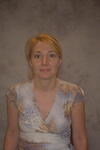Oana Catu
Results from the experiments at RHIC showed evidence that a strongly interacting medium is formed in ultra-relativistic heavy ion collisions at RHIC energies. Di-hadron correlations provide major contributions to the support of this claim. Namely, on the away-side of a high transverse momentum (pT) trigger hadron, the associated jet-like hadron yield is strongly suppressed at high pT in heavy ion collisions, as opposed to d+Au collisions which show behavior similar to p+p collisions. These two facts indicate that the suppression is a result of the scattered parton losing energy in the medium. Various theoretical calculations presently available attempt to use present data in order to estimate the initial gluon density. We attempt to constrain the models by using the dependence of the parton energy loss on the path length through the medium. To this end, we present a systematic study of the near- and away-side di-hadron correlation yields as a function of number of participant nucleons (Npart ) for 3 systems with different geometries (d+Au, Cu+Cu and Au+Au) at [special characters omitted] = 200GeV in STAR. Taking the method one step further, we investigate the modification of the away-side di-hadron fragmentation functions for high pT particles in Au+Au and Cu+Cu. A comparison with theoretical predictions using NLO pQCD is also presented. The calculation allows the determination of the transport coefficient of the medium ( qˆ) using previous Au+Au data. We compare it with our data for the various centralities in Au+Au and Cu+Cu, corresponding to various Npart and different geometries. The data presented in this work puts constraints on the different models and will allow a more quantitative description of the properties of the matter formed in ultra-relativistic heavy ion collisions.
